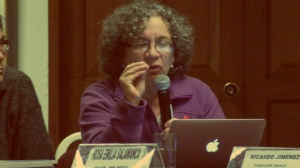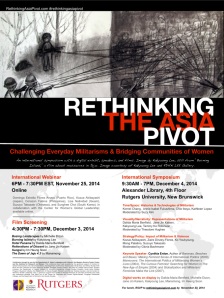By Sumshot Khular
Northeast India is a home to more than 500 indigenous peoples (tribes, speaking different languages and cultures). Nagas are over 3 millions peoples living in India and Myanmar, separated by the international boundary between India and Myanmar/Burma. With a distinct culture and identity, they reside in lands that include beautiful mountainous terrain, plains and valleys endowed with rich natural resources. The over 6 and half decades of violence in the Naga areas is due to the “non-recognition of the right of Indigenous Peoples to their lands, territories and resources is the root cause of violence brought about by development aggression” e.g., the Mapithel Dam, Tipaimukh Dam, Chakpi Dam in Manipur and many more yet to come up; the railways project, Trans-Asian Highways project and gas pipeline.
Militarisation of indigenous land and territories is the central primary concern of the Naga People, and I would like to draw attention to the history of subjugation and oppression of the rights of Naga indigenous peoples, especially through the extensive use of Indian state military forces. There are many incidents of grave violations of human rights perpetuated by military forces in the guise of maintaining law and order in indigenous territories.[i] The legacy of militarization, including rape, arbitrary arrests, torture, inhuman and degrading treatment, extra-judicial killings, looting, sacrilegious acts against religious and sacred places, forcible and unlawful occupation of large tracts of indigenous lands and territories, and uncompensated use of natural resources has been common experiences of all indigenous societies in Northeast India, including the Naga Peoples.
The situation in Manipur has gone on for too long and is now a normalized part of life, as all have become immune to the militarized systems. Women have given up their fight to ending gender-based violence at home and in public spaces. They continue to protect our people, land, forest environment and natural resources, so every day is a campaign day for women in several areas.
Therefore, we strongly reiterate that militarization, instead of being a solution, has been the root cause of all human rights violations in Manipur, as well as in other parts of NE India. Using laws such as the Armed Forces Special Powers Act (1958), Disturbed Area Act, National Security Act, the Government of India and its state governments have legitimized acts of violence and rights violations committed by their forces and have supported and perpetuated a culture of impunity and immunity for state forces.[ii]
Apart from the clear-cut rights violations such extra judicial killings, arbitrary arrest, torture, degrading and other inhumane treatment, militarization disrupts many aspects of indigenous life including routine economic activities and farming. Militarization also nurtures armed conflicts and virulent racism and also erodes community cohesiveness.
I would like to further draw attention to the uneven burden of militarization on women and children. Widespread discrimination on the basis of their gender makes them extremely vulnerable to the affects of militarization, resulting in further disenfranchisement and denial of their rights. Violations of rights committed against members of society have a direct bearing on the well being of women and children. As such, the impact of militarization is profoundly devastating for women and children and to our NE indigenous peoples who went to study or work facing all racial discrimination and killings in recent years across several cities in India.[iii] Our women are not spared in our own home state, nor in different metro-cities of India, whether in New Delhi, Bangalore, or Mumbai. We are met with torture, rape, sexual harassment in the workplace, killings and trafficking in the recent years which is increasingly alarming and threatening our survival in the world’s largest democracy, the ‘land of Gandhi’ and the ‘India Shining’, a slogan of Modi’s time signifying the trajectory of development of India.
The impact of militarization is not only limited to physical and emotional security of individuals, but has much wider social, economic and political implications. For people in the Northeast, especially the Nagas, who are negotiating a peaceful settlement to the protracted conflict in the region, militarization has often negated the small progress made towards achieving peace and stability. Further, militarization has been used as a tool to forcefully impose developmental agendas, such as the mega-dam constructions, trans-international highways, trans-Asian railways, gas pipeline, and high voltage power grid transmission lines that are anti-people and against their expressed wishes and approval. The Tipaimukh Dam, Mapithel Dam, Chakpi River Dam are glaring examples of the linkages between developmental projects and militarization.[iv]
We applaud the Tangkhul Shinao Long (Tangkhul Women’s League) for the tireless struggles from days old and in the Shakok–H-Godah Incident in 12 August 2009 and also the recent Ukhrul killing of an ADC member on 12 July 2014 and following imposition of Section 144 of Criminal Procedure Code and deployment of counter insurgency forces; Manipur Police Commando (MPC) and Indian Reserved Battalion (IRB) in Ukhrul without any justification since 13 of July 2014 followed by the use of high caliber live rounds by the counter insurgency forces against peace rallyists, killing two civilians while injuring more than 35 people on 30August 2014.
Women continue to keep vigil day–in and day-out to make sure no further violence occurs and that peace prevails. The great strength of our women cannot be brought down by bullets. Challenges in advocating for women’s rights are:
- Strong traditional customary practices (where patriarchy roots in)[v]
- Feeling that ‘gender’ is a women’s issue not everybody’s business. Unless it becomes the business for all, from the State to men in families, it is going to take much longer time to change attitudes.
- High time for men in uniform to be trained on gender and women’s rights, along with men in local communities-through changing attitudes will take time–BUT WE WILL NEVER GIVE UP!
Our Priorities include translation of CEDAW, the Domestic Violence Act, and other relevant international human rights instruments into our local languages as well as organised ongoing awareness on Violence Against Women (VAW) and trainings in communities and for law enforcement.
Many inroads in village councils have been made, where we have women secretaries, women pastors, and two women in the Forum for Naga Reconciliation (FNR) and United Naga Council (UNC) as its Arts and Social Secretaries. Few tribes have women in their Tribe Apex bodies. These are beginnings and we will win!
The recent election of President Modi, and what this means for women’s human rights, ending gender-based violence, inequality, and discrimination globally-is a great worry when we recall the Gujarat carnage in 2000 that took place under his chief ministership. We know how hard it was for Muslim women in that situation and the same has repeated in Muzaffarnagar in Uttar Pradesh recently. The movement against so-called Lovejihad is gaining ground among Hindu nationalists in the name of protecting women from the non-Hindu ‘the other lover’, curtailing the rights and freedom to choose one’s own partner by one’s own choice. Where will the new schemes launched in the name of the poor and untouchable people lead to-out from poverty or trap people in tighter walls of poverty?
Akpanpaak Chaak Inna! (Thank you) Kuknalim! (Long Live)
Ms. Sumshot Khular is a Lamkang Naga indigenous from Thamlakhuren village in Chandel district of Manipur state in India. She is an active human rights and peace activist, at present serving as the Executive Director of Community Action and Research for Development,a grassroot organization working for education, human rights, gender, development, peace based in Chandel district in Manipur. She has an MA in the Theory and Practice of Human Rights from Essex University, UK and is the Vice President of the Naga Women Union since October 2013 for a term of three years.
[i] Operation Blue Bird in Oinam village 1987, where pregnant women were killed, raped in front of their husbands and other men, young children and old were also killed, pregnant women were made to deliver in front of the armies. We cannot forget what happened in Mitikhri village in Pochury area on 6 September 1960, the Punjab Regiment posted at Kangjang village reached Matikhrii village around 10 am. The entire village was encircled in three rings and all the villagers were ordered to gather in one place. Men folk were separated from women and children. All the men were ordered to keep jumping and do sit-ups, for more than five hours in the scorching sun, naked. Any signs of tiredness were met with kicks and hits with rifle butts. Then just before sunset, Indian army not satisfied with the punishment meted out to the villagers, rounded them up inside the Village chief’s house and were forced to sit heads down like a lamb being lead to its slaughter. The Indian army did not even allow the loved ones to perform last rites and rituals for the dead. All the dead bodies were dumped inside the village chief’s house and were burnt down to ashes along with the other houses and granaries. The women and children who had fled to the jungle to evade the horror and torture of Indian Army came back the next morning to find the whole village burnt down to ashes.
[ii] The recent Ukhrul firing upon silent protestors on 30 August killing two men after five days of imposition of CrPC 144, clamping the district following a killing on 13 July at Finch Corner before Ukhrul some 20 kms away. Their wives expecting the first born babies in October became young widows and children will grow up as orphans.
[iii] Over 400 cases of racial abuse, attacks and murder of NE people recorded at Northeast Helpline, this year.
[iv] Mrs. Lungnila , a 70 year old woman, mother of 9 children and the sole breadwinner in the family was hit by a police canister on her skull and injured her brain, during the silent protest march against Mapithel dam in 2008 and today she is paralyzed permanently. More than 20 women were injured that day.
[v] Few tribes have women in their Tribe Apex bodies. Once men are aware they need women at equal par in leadership or in any work to progress. However, it takes time to change the very patriarchal mindset and traditions and customs and institutions that promote them.



